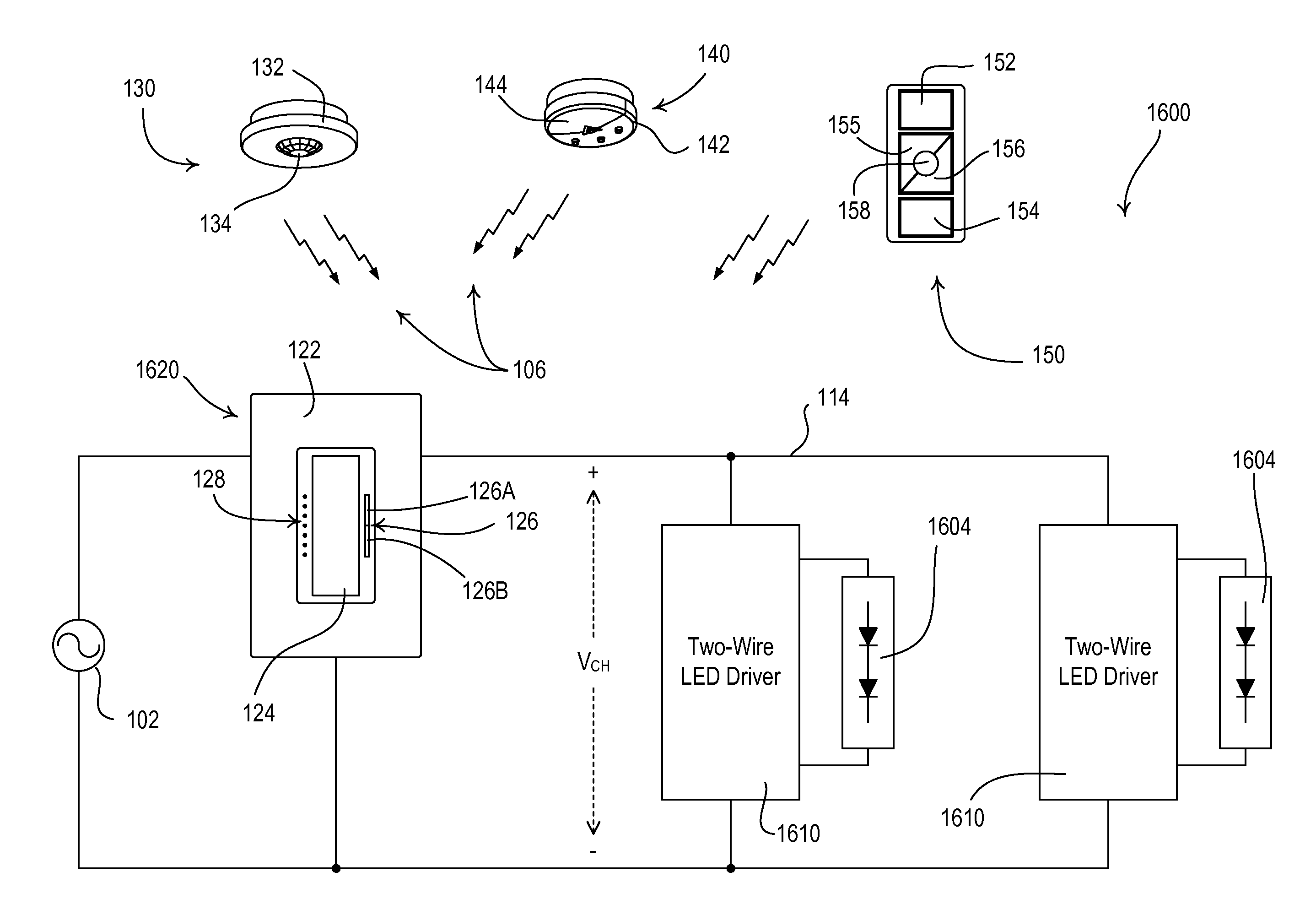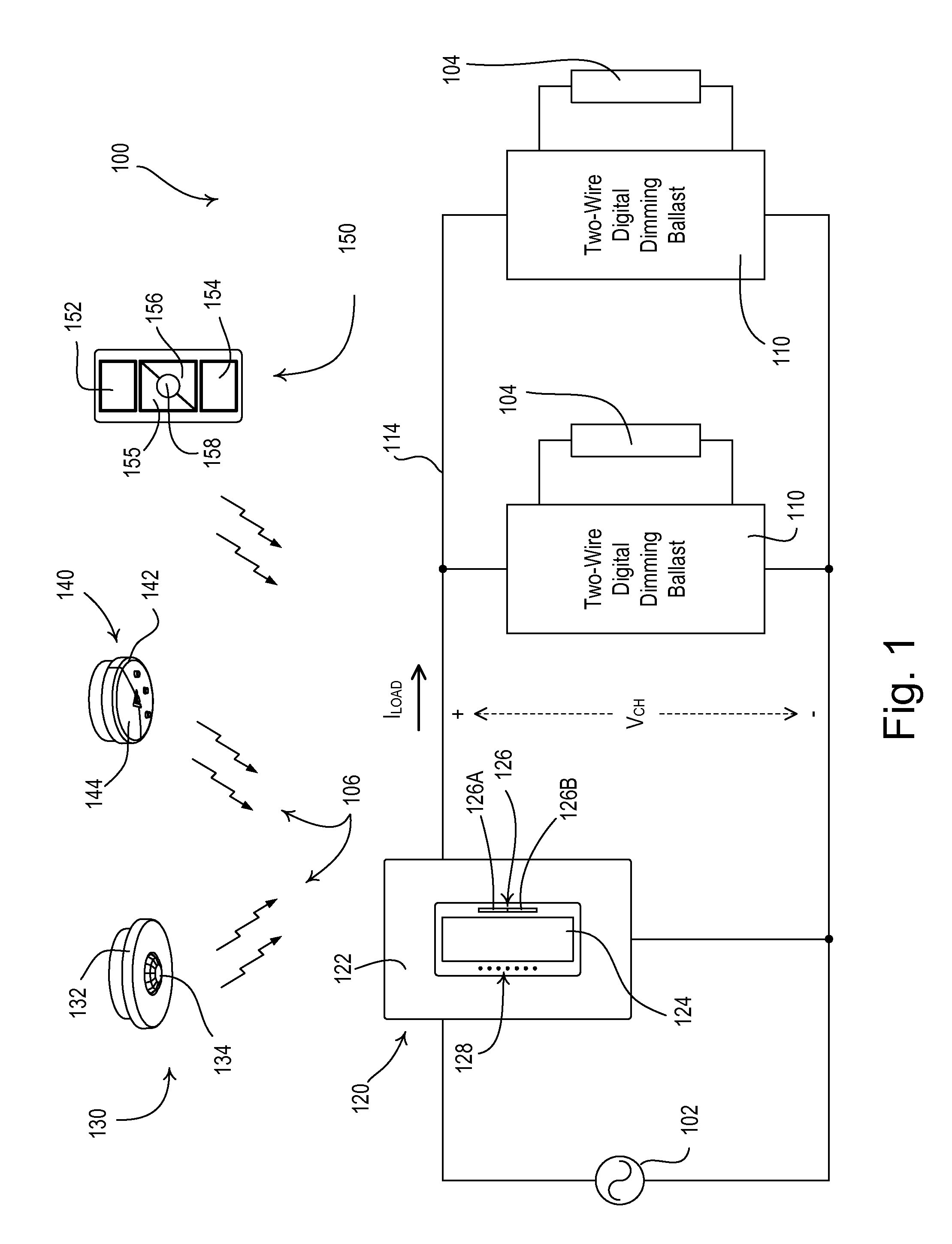Digital load control system providing power and communication via existing power wiring
a load control system and digital technology, applied in the field of two-wire load control, can solve the problems of inability to connect to the neutral side of the ac power source in the wallbox where the mechanical switch is located, requiring subsequent repair, and high cost of running additional wiring
- Summary
- Abstract
- Description
- Claims
- Application Information
AI Technical Summary
Benefits of technology
Problems solved by technology
Method used
Image
Examples
first embodiment
[0084]FIG. 1 is a simple wiring diagram of a load control system 100 having a plurality of two-wire load control devices, such as two-wire digital dimming ballasts 110, according to the present invention. The two-wire digital dimming ballasts 110 are coupled to respective lamps 104 for controlling the intensities of the lamps to a desired lighting intensity LDES between a low-end (i.e., minimum) intensity LLE (e.g., approximately 1%) and a high-end (i.e., maximum) intensity LHE (e.g., approximately 100%). The load control system 100 also comprises a digital ballast controller 120 (i.e., a remote control device) that is adapted to be coupled in series electrical connection between an alternating-current (AC) power source 102 and the two-wire digital dimming ballasts 110 via a circuit wiring 114. In other words, each digital dimming ballast 110 is coupled in series with the digital ballast controller 120 across the AC power source 102. As shown in FIG. 1, the digital ballast controlle...
second embodiment
[0140]FIG. 12 is a simplified flowchart of the timer interrupt procedure 700 that is executed by the microprocessor 214 of each digital ballast controller 120 to generate the reference and data edges of the transmitted digital messages according to the present invention. The microprocessor 214 executes the timer interrupt procedure 700 when the value of the timer equals the set interrupt time, for example, as set during the zero-crossing procedure 600. The microprocessor 214 first renders the controllably conductive device 210 conductive at step 712. If the variable m is equal to zero at step 714 (i.e., a reference edge was generated at step 712), the microprocessor 214 sets a base time t0 equal to the present value of the timer (i.e., the time at which the reference edge was generated) at step 716. The microprocessor 214 then prepares to generate a data edge in the next half-cycle by setting the variable m to one at step 718 and executing a data edge procedure 800, which will be de...
third embodiment
[0157]As previously mentioned, in some retrofit applications, the neutral wire coupled to the neutral side of the AC power source 102 may not be available in the wallbox of the digital ballast controllers 120. FIG. 20 is a simplified block diagram of a load control system 1300 comprising a two-wire remote control device, e.g., a two-wire digital ballast controller 1320, that is adapted to be coupled in series electrical connection between the AC power source 102 and the two-wire digital dimming ballasts 110 without a connection to the neutral side of the AC power source according to the present invention. The load control system 1300 further comprises an active load circuit 1390 that is coupled in parallel with the two-wire digital dimming ballasts 110 for providing a path for a charging current of a power supply 1420 (FIG. 21) of the digital ballast controller 1320 to be conducted as will be described in greater detail below. For example, the active load circuit 1390 may be housed ...
PUM
 Login to View More
Login to View More Abstract
Description
Claims
Application Information
 Login to View More
Login to View More - R&D
- Intellectual Property
- Life Sciences
- Materials
- Tech Scout
- Unparalleled Data Quality
- Higher Quality Content
- 60% Fewer Hallucinations
Browse by: Latest US Patents, China's latest patents, Technical Efficacy Thesaurus, Application Domain, Technology Topic, Popular Technical Reports.
© 2025 PatSnap. All rights reserved.Legal|Privacy policy|Modern Slavery Act Transparency Statement|Sitemap|About US| Contact US: help@patsnap.com



